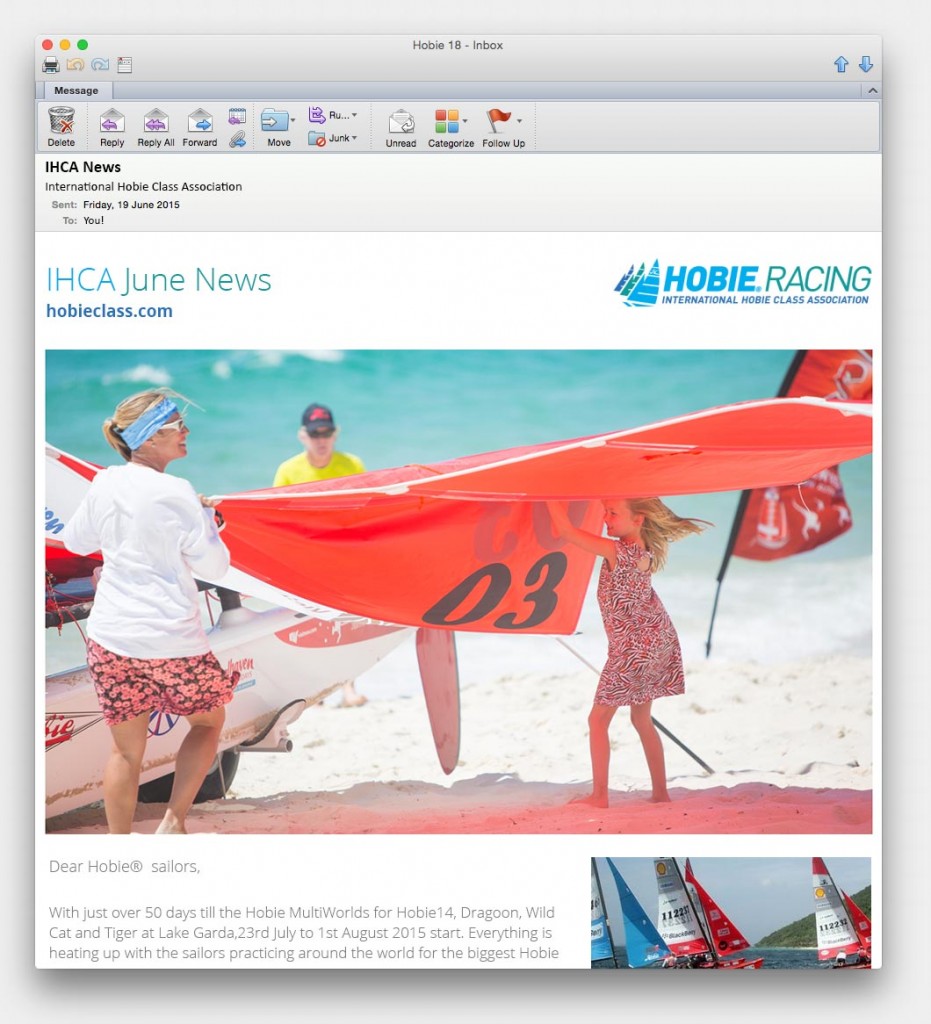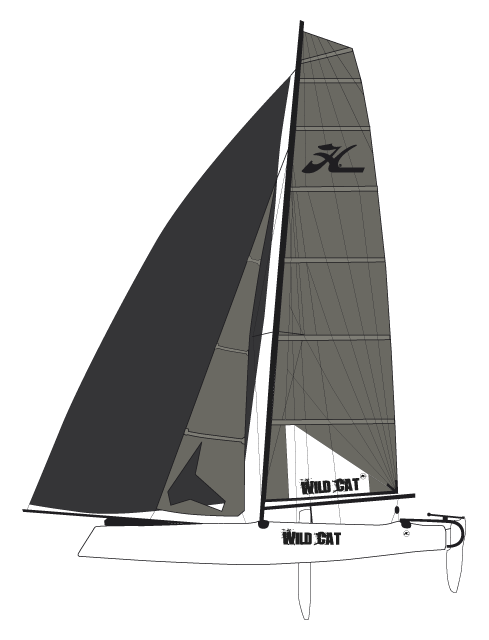
Join Our Mailing List
Sign up for our mailing list to receive the monthly IHCA Newsletter and stay up to date with everything happening on the global Hobie Racing scene.
The Wild Cat is Hobie’s next generation extreme racing machine and current Formula 18 design. Introduced in January 2009, the Wild Cat ultimately replaced the Hobie Tiger. Designed by renowned fluid dynamics expert Dr. Martin Fischer (designer of the Capricorn F18, A Class catamarans and America’s Cup 45 collaborator) and manufactured by Hobie Cat Europe, the Wild Cat incorporates the latest in Formula 18 design philosophies. The include: Wave piercing, planing hulls; Distinctive hull strakes to reduce friction and increase speed in moderate to heavy winds; A shallow V-shaped keel rocker; Longer, high aspect ratio carbon daggerboard and rudder foils; All-aluminum wing mast.
Hobie Europe had been considering a new F18 design since the early 2000’s. After the introduction of the Capricorn F18 in 2004 they had some doubts about the Tiger’s continued dominance of the class. By 2006 Hobie Europe knew the Tiger was outdated and they waited to see what direction the other F18 designs were going to take. In 2008, with a clean slate and carte blanche from Hobie, Dr. Fischer began designing the Wild Cat. The goal – design an F18 capable of winning the world title. The result is what you see today…a seriously fast and technical boat.
The International Wild Cat rules state that boats must weigh a minimum 180 kg (396 lbs) full up. Typically, Wild Cats are coming from the factory about 2 kg (178 kg or 391 lbs) light. Corrector weights are added as necessary to bring the boat up to the minimum requirement.
Wild Cat One-Design rules specify a minimum crew weight of 140 kg (308 lbs). F18s use a graduated weight scale and sail plan size depending on crew weight. Typically the all-round optimum Wild Cat crew weight for F18 racing is 340 to 360 lbs and uses the large sails.
The Wild Cat was designed for windy conditions and the boat excels in a breeze. The performance groove is fairly narrow at about +/- 5 degrees. Outside the groove the boat is still fast but is not at its optimal performance. Downwind, the Wild Cat really comes alive. The hulls were designed to plane downwind, and there is a noticeable increase in speed when they do. The spinnaker has a tendency to lift the bows up when sailing off wind – usually broad reaching at a 45 degree angle to the wind. This means only the back 50% to 60% of the boat is in the water, planing on the flatter rear half of the “V” rocker. Once in this groove the Wild Cat lives up to its name. It’s an exhilarating ride. A light touch on the tiller is needed though. You need to make small and deliberate movements because the boat is very responsive – like having power steering. Some skippers even say it’s “twitchy”. Fast, jerky movements on the tiller can cause loss of control or a stuffed bow and ultimately pitchpoling. A hull is flown downwind for additional speed…turning downwind for control and stability. Keep the traveler centered and the main sheeted in snug but not overly tight – especially in breeze above 15 knots – while going downwind. The top of the mast is subjected to a tremendous amount of pressure from the spinnaker. Using the main as your backstay will prevent the mast from breaking. Keep your weight aft…the crew is usually trapping off the hull behind the skipper to help keep the boat flat while working the spin. When sailing downwind you’ll need to raise up the daggerboards about 50% to keep from tripping over them and potentially capsizing. The Wild Cat is both smooth (from the wave piercing bows) and stable upwind. Mast rotation, downhaul manipulation along with diamond wire tension, spreader rake, mast pre-bend and mast rake are key to depowering the boat, keeping it flat in a breeze. In light conditions, you need to keep the boat powered up (by backing off on the aforementioned adjustments) and moving. The high aspect ratio daggerboards generate lift when moving…point too high and the boat will stall. Overall, a very exciting, fast and demanding boat to sail.
There have been a few minor changes and upgrades (mostly for convenience) since the first boats came out of the molds. Some of those changes are a forked mast step, stainless steel rudder arms, addition of grooves in the daggerboard wells and daggerboards for a uphaul system and 30 cm longer daggerboards. Retrofit kits/parts are available for older Wild Cats and these changes are now incorporated into current production boats. Beam reinforcement to stiffen the boat is an add-on kit for older boats. This is supplied with the newer boats.
Recent class rule changes have allowed for a more powerful (12:1) mainsheet and longer (+30 cm) daggerboards. Another upgrade example is the mast rotation release. This is a coarse adjustment allowing the rotator to be released immediately when transitioning downwind. Pull on the rotator line when transitioning back to weather and you’re automatically back to your upwind setting. Any other modifications usually are personal preference like control line locations or colored lines for easy identification. You’ll need to file down the trailing edges of the foils to eliminate the hum.
The Wild Cat is a very robust platform insofar as F18s are concerned. However, there are a few things to consider that will extend the competitive life of the boat. Trailer cradles are an absolute must to spread the load bearing weight across a large section of hull. Rollers will only dent and damage the hulls. Beach wheels are another necessity for launching and retrieving. Roll your boat directly into and out of the water…never drag your boat across the sand. This will prolong the bottom contour of the hulls. Be sure to use the same trailer cradles on your beach wheels. Once on the sand/grass/parking lot and still on the beach wheels, use stern protectors to keep the entire boat off the ground. Roll, never fold, your jib and main. Flake your spinnaker for storage.
Used Wild Cats are now starting to show up in the secondary market. Look at the general condition of the hulls…are there any cracks at the crossbar saddles, in the glue seam, rigging tangs or daggerboard wells? Check for any repaired areas. Inspect the foils…are they chipped or dinged? Look at the sails…are the main and jib rolled? Look for any rips/tears or repaired areas. Spinnakers take a lot of abuse with hoisting and dousing. Check for rips/tears/holes and the crispness of the material. It should not feel like limp tissue paper. It might be best to get a new spin if you’re going to race. Check all the rigging to be sure there are no broken strands or kinks.

| World Sailing Status | International Class |
| Construction | Fiberglass / Foam Sandwich |
| No. of Crew | 2 |
| Designer | Martin Fischer / Hobie Cat Europe |
| National Origins | France |
| Year Designed | 2008 |
| Approx Number Built | 1000 |
| Number of Trapeze | Double |
| Hull Length | 18 ‘ / 5.46 m |
| Beam | 8′ 6″ / 2.46 m |
| Draft (rudder up) | 7″ / 0.18 m |
| Sail Area | 454 sq. ft. / 42 m2 |
| Sail Material | Pentex laminate (main/jib) |
| Daggerboards | Carbon composite |
| Boat Weight | 397 lbs / 180 kg |
| Max Load | 529 lbs. / 240 kg |